PC
game review
Uru:
Ages Beyond Myst
Publisher:
Ubisoft. Developer: Cyan Productions. Genre:
Adventure. Release Date: November 11, 2003.
Requirements: 256 MB RAM, 4X CD-ROM, 32 MB VRAM,
2000-MB disk space, and DirectX v9.0
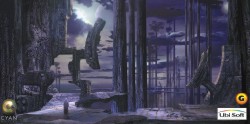 Ten
years ago, graphical adventure games were turned on their ear by Myst.
Designers Robyn and Rand Miller produced a distinctive game in which
you explored a colourful, fascinating world from a first-person perspective.
Millions of sold copies and countless knockoff games later, Myst remains
one of the most popular computer games of all time. Myst was also
one of the first games to drive players to get CD-ROM drives. The
latest game in the series, Uru: Ages Beyond Myst (formerly known as
Myst Online), had originally been intended to add an all-new innovation
to the genre: Uru Live, an online multi-player version of the game.
You were supposed to have been able to pick up Uru and play it over
the Internet, exploring the ruins of the ancient D'ni civilisation
with thousands of other players.
Ten
years ago, graphical adventure games were turned on their ear by Myst.
Designers Robyn and Rand Miller produced a distinctive game in which
you explored a colourful, fascinating world from a first-person perspective.
Millions of sold copies and countless knockoff games later, Myst remains
one of the most popular computer games of all time. Myst was also
one of the first games to drive players to get CD-ROM drives. The
latest game in the series, Uru: Ages Beyond Myst (formerly known as
Myst Online), had originally been intended to add an all-new innovation
to the genre: Uru Live, an online multi-player version of the game.
You were supposed to have been able to pick up Uru and play it over
the Internet, exploring the ruins of the ancient D'ni civilisation
with thousands of other players.
However, this
functionality wasn't available at the game's release and is still
not widely available. The full-fledged online version will launch
at an unspecified future date.
Fortunately,
the single-player version of Uru is a very good game in its own right,
despite being rather short. The fully 3D game lets you play as an
explorer drawn to an excavation site at which the ruins of the lost
D'ni civilisation have been discovered. Using various tomes, you travel
across four different realms, or "ages," to collect seven
different parts of a magical symbol that must be compiled in order
to complete your adventure in each age. To this end, Uru takes an
unusual approach with its control scheme and presentation.
 Uru
is the first game in the series that lets you actually see your character
from a third-person view--a character you generate at the start of
the game by choosing your appearance and gender. This doesn't have
much relevance in the single-player game, though having a unique-looking
character may prove more significant in the multi-player portion.
Uru also has absolutely no inventory system your character does not
carry any items and therefore won't encounter any inventory-based
puzzles (though there is one puzzle late in the game that requires
you to carefully transport a swarm of glittering fireflies that "stick"
to your character's body). The game also has hardly any interface
elements. You carry the mystical Relto tome to return to your own
personal hub area between the different ages. You can pull up some
game menu options, but these appear at the bottom of the screen as
small icons and disappear by default so that your view of your surroundings
is completely uncluttered.
Uru
is the first game in the series that lets you actually see your character
from a third-person view--a character you generate at the start of
the game by choosing your appearance and gender. This doesn't have
much relevance in the single-player game, though having a unique-looking
character may prove more significant in the multi-player portion.
Uru also has absolutely no inventory system your character does not
carry any items and therefore won't encounter any inventory-based
puzzles (though there is one puzzle late in the game that requires
you to carefully transport a swarm of glittering fireflies that "stick"
to your character's body). The game also has hardly any interface
elements. You carry the mystical Relto tome to return to your own
personal hub area between the different ages. You can pull up some
game menu options, but these appear at the bottom of the screen as
small icons and disappear by default so that your view of your surroundings
is completely uncluttered.
Some of Uru's
puzzles are a bit more annoying than others. as mentioned, your basic
goal in each area is to find the seven parts of a hand-shaped symbol
to complete your adventure in each area. These symbols are often hidden
behind corners or obscured by environmental objects that must be moved
(or moved to) by solving puzzles. Uru's puzzles are generally challenging,
and it even has a few jumping puzzles, though you can't die--if you
fall into a pit, for instance, you'll simply get whisked back to your
hub area. To the game's credit, the puzzles at least start off simple,
then become increasingly difficult. But toward the end, several of
the game's logic-based puzzles require careful analysis and lots of
trial and error--in some cases, to the point of being very, very annoying.
This is especially true of the few physics-based puzzles that Uru
has to offer--since you don't have an inventory in which to carry
things, you're sometimes required to nudge nearby items (such as rocks,
bones, and chairs) into certain positions. The game uses a control
scheme reminiscent of a first-person shooter (you move by walking
forward, walking backward, turning, and sidestepping), but it's too
imprecise to handle nudging objects effectively. While solving these
puzzles, you'll spend an undue amount of time coaxing objects into
place while fervently wishing the control scheme weren't so clumsy
or that you could just reach down, pick up that rock, and put it on
the pressure plate yourself.
Since you're
exploring the ruins of an ancient culture, you're completely alone
for most of your adventures. That means there are no helpful characters
to provide tips, and the game has no in-game hint system either, so
you'll usually walk into a room filled with strange symbols and be
expected to figure out what to do next. You'll also find out about
the game's story only through scattered journals and other writings
that you recover in different areas. Much of it, however, deals with
long-forgotten characters of the D'ni race--characters whose intricate
and storied lives will probably seem completely meaningless to you
if you're not already familiar with the series.
Beginners and
veterans alike will appreciate Uru's exceptionally high production
values. Using a careful eye, you can spot minor inconsistencies in
Uru's visual presentation--the lack of ground shadows on your character,
how tides of water in certain places clash without affecting each
other etc. Still, Uru is all about its colorful and imaginative environments,
which are uncluttered by any interface elements and adorned with incredibly
clean textures.
Why
does everybody loves
Raymond
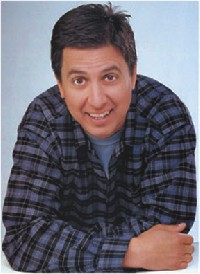 Ray
Romano admits that he always knew he could make his friends laugh,
but he never really gave stand-up comedy any serious thought until
one fateful open-mic night at a New York comedy club in 1984. He did
well, the bug bit hard, and Romano was smitten. After stints at odd
jobs, including futon mattress delivery boy and bank teller by day,
and journeyman comedian by night, he decided to leave the 9-5 ranks
and pursue comedy full-time, eventually winning a stand-up comedy
competition sponsored by a major New York radio station that same
year.
Ray
Romano admits that he always knew he could make his friends laugh,
but he never really gave stand-up comedy any serious thought until
one fateful open-mic night at a New York comedy club in 1984. He did
well, the bug bit hard, and Romano was smitten. After stints at odd
jobs, including futon mattress delivery boy and bank teller by day,
and journeyman comedian by night, he decided to leave the 9-5 ranks
and pursue comedy full-time, eventually winning a stand-up comedy
competition sponsored by a major New York radio station that same
year.
After nearly a
decade as a journeyman stand-up comic, Ray Romano came to television
audience's attention with a 1991 appearance on "The Tonight Show
With Johnny Carson". Shortly after, his career began to ascend.
With his dark looks, nasal 'Noo Yawk' accent and deadpan delivery,
Romano offered commentary mixing familial humor with off-beat observations,
focusing away from political and topical humor. He impressed late
night host David Letterman enough for Letterman to develop a sitcom
to showcase his unique talents.
Born on December
21, 1957 in Queens and raised in the borough's middle class Forest
Hills, Romano attended high school with Fran Drescher. After graduating
in 1975, he worked at various jobs (gas station attendant, bank teller,
futon deliveryman) while dabbling in comedy, making appearances at
open mike nights at various clubs. In 1987, he decided to pursue stand-up
full-time. Two years later he won $10,000 and priceless exposure in
a New York comedy contest that jump-started his career. After his
appearance with Johnny Carson, Romano was featured in HBO's "The
15th Annual Young Comedians Festival, hosted by Dana Carvey"
and went on to perform in several other comedy showcases.
David Letterman
was so impressed with the comic's 1994 appearance on his talk show
that he had his production company Worldwide Pants develop a sitcom
based on Romano's observational family comedy. "Everybody Loves
Raymond" (CBS, 1996- ) was tailored to reflect Romano's upbringing
and talents. He was cast as a married sportswriter with three children
whose pushy mother (Doris Roberts), out-there father (Peter Boyle)
and idiosyncratic brother (Brad Garrett) are neighbors.
With relatable
true-to-life dialogue, multidimensional characters and wacky, fact-based
situations, "Everybody Loves Raymond" was a rare series,
a family sitcom that managed to be fresh but not overly edgy. Described
by many critics as "'Seinfeld' with kids", the show lacked
its predecessor's zany inhumanity and instead had a touching but skewed
focus on relationships. "Everybody Loves Raymond" also steered
clear of the grating preciousness all too common in family sitcoms,
presenting scenes with children that were engaging and realistic,
not saccharine and exploitative. While the network highly touted the
sitcom and critics praised it, its Friday night time slot was hardly
a ratings grabber.
A switch to Monday
nights beginning in the 1997-1998 season proved just what the series
needed, and the show built up an impressive audience despite competition
from major contenders "Monday Night Football" (ABC) and
"Ally McBeal" (Fox). Going from ratings rankings in the
80s to frequent appearances in the Top Ten, the flourishing sitcom
finally won Emmy recognition in 1999, when Romano was nominated as
producer and lead actor. The following year he repeated in those categories
and also grabbed a writing nod, continuing his run of Lead Actor,
Comedy Series nominations in 2001. A self-described "stand-up
comedian with a day job", Romano's acting skills increased as
the series progressed, and Raymond Barone the TV character began to
develop his own distinct persona. Romano made his feature debut with
a voice acting turn as a wooly mammoth in the animated "The Ice
Age" (2002).
Did You Know?
Ray is married to Anna and they have four children, Alexandra, twin
boys Matthew and Gregory and Joseph.
Ray is 6'4" tall.
In real life his brother is a Sergeant for the NYPD. They posed for
a recruiting poster together in 2001.
Ray won $125,000 for the NYPD D.A.R.E. Unit on the "Who Wants
To Be A Millionaire" celebrity episode.
In 2001, Ray made $19 million annually for his sitcom 'Everybody Loves
Raymond.'
Ray met his wife at his first job as a bank teller in 1985.
He won a comedy contest sponsored by a local New York radio station
in 1989, which basically started his career.
It was David Letterman who signed Ray a deal to write a sitcom based
on his stand-up comedy.
He is also the author of the New York Times best-selling book based
on his comedy, "Everything and A Kite."
Movie
Review
Barbershop
2:Back in the business
by Gorkha
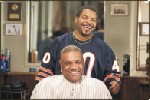 A
barbershop is a place for a community get together, good natured ribbing,
talks on politics, heartfelt discussions and a lot of one-upmanship.
And of course at times people cut hair also. This is the basic theme
of the movie. In 2002, Ice Cube took that idea to star in and produce
the surprise hit "Barbershop" set in a neighborhood place
on Chicago's Southside.
A
barbershop is a place for a community get together, good natured ribbing,
talks on politics, heartfelt discussions and a lot of one-upmanship.
And of course at times people cut hair also. This is the basic theme
of the movie. In 2002, Ice Cube took that idea to star in and produce
the surprise hit "Barbershop" set in a neighborhood place
on Chicago's Southside.
Surprisingly
the sequel happens to be better than the first one. Hardly no other
movie has achieved this feat since Terminator 2.
First
of all Ice Cube happens to play a tough guy in almost all his movies
busy shooting up people in gangland wars. Here he plays an ordinary
family man who chooses a small business inherited from his father
over a gangster's tainted money.
Synopsis:
Well, frankly the plot is rather loose. Ice Cube is great, once again,
as the intelligent good-hearted mediator of all the crazy antics.
 This
time, Calvin's (Ice Cube) shop is finally paid for or in their own
terms it is "solid". The problem is that competition is
also solid. The dry cleaner, corner grocery and a lot of old shops
are being replaced by the modern electronically sterile places that
sell drink from a machine. Worse still Calvin finds himself in a fix
when a huge franchise called Nappy Cutz is opening across the street
from his family-owned business, a business that's been cutting and
cutting up since 1958.
This
time, Calvin's (Ice Cube) shop is finally paid for or in their own
terms it is "solid". The problem is that competition is
also solid. The dry cleaner, corner grocery and a lot of old shops
are being replaced by the modern electronically sterile places that
sell drink from a machine. Worse still Calvin finds himself in a fix
when a huge franchise called Nappy Cutz is opening across the street
from his family-owned business, a business that's been cutting and
cutting up since 1958.
Nappy
Cutz has a huge joint fitted with state-of-the-art equipment, massage
chairs, funky drinks and in this day and age, a Web site. Calvin's
place has, in his words, "real people, real conversation and,
most of all, real barbers." As if that is not enough nappy is
assisted by a corrupt local politician.
Well,
there you have it. The plot is not very substantial. In fact, it's
the type of movie where you just revel in the different wacky characters.
The
movie has other stuff going on, too. In flashbacks set in the late
60s, we see how the outrageous Eddie (Cedric the Entertainer) first
came to the shop. Isaac (Troy Garity) has finally reconciled with
the fact that no matter how "black" he becomes he is still
a nice Jewish boy. Also he has become the best cutter in the shop.
Underlying and unpredictable romance between tough girl Terri (Eve)
and womanizing Ricky (Michael Ealy) are worth looking out for.
.And
then there's the new next-door neighbor in the adjoining beauty shop
- Queen Latifah in an extended role as a sassy beautician. She is
so good in this movie that there will be a spin-off starring her in
"Beauty Shop".
It's
a movie that's affectionate, smart and hilarious offering a warm-hearted
camaraderie between lovable characters. With the exclusion of gross
jokes this happens to be a good family-values comedy.
The Punisher
Compiled
by Gorkha
 The
Punisher is a grim story dealing with a lot of death. The comics have
their copious amount of blood dripping down very sequence. What's
great about this comic is that it does not deal with grim reality
with kid gloves. You get cold, hard visuals with a touch of sarcastic
humor. Too bad none of the bookstores keep this title in stock for
me to waste my money on.
The
Punisher is a grim story dealing with a lot of death. The comics have
their copious amount of blood dripping down very sequence. What's
great about this comic is that it does not deal with grim reality
with kid gloves. You get cold, hard visuals with a touch of sarcastic
humor. Too bad none of the bookstores keep this title in stock for
me to waste my money on.
The basic plot
is that he is an ex-US marine whose family was killed in Central Park,
New York, when they inadvertently witnessed a gangland execution.
The mobsters murdered Frank's wife, Maria, and their two children,
Frank Jr. and Barbara. Frank was left to die of his injuries.
On that day, Frank
Castle vowed to use his skills and experience to wage a one-man war
on crime. He set out to punish all criminals, and more often than
not, that punishment takes a very lethal form indeed. Castle has been
sent to prison on numerous occasions in the past, including the notorious
Ryker's Island, but has always managed to escape.
He had an expert
computer hacker helper named Linus "Microchip" Lieberman
who, after many years of friendship, started having disagreements
with Castle's methods, resulting in the break-up of their working
relationship. Frank went mad over this and, in a fit of rage, was
involved in a gunfight with rogue SHIELD agent Sudden Death, which
resulted in the death of Microchip, as well as Frank's incarceration
by SHIELD agent Col. Nicholas Joseph Fury.
While incarcerated,
Frank was brainwashed through hypnosis into believing that Col. Fury
was the man who killed his family, which started him on a suicide
run, resulting in the apparent death of Fury and the re-incarceration
of Castle. Due to a frame-up by the mercenary Bullseye, Frank was
sentenced to death by the electric chair, which he survived with the
intervention of the Geraci crime family. Not long after, Castle joined
the family in order to infiltrate their ranks and destroy them from
within. His arch-nemesis, Jigsaw, with help from Tombstone, Firefox,
and the Hatchetman, destroyed the Geracis when their dying Don betrayed
them. In revenge, Frank killed Jigsaw and Tombstone while letting
Hatchetman escape after renewing his honour by killing Firefox.
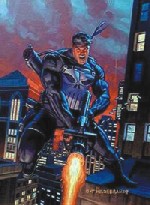 In
what has been termed "Onslaught", Frank helped SHIELD agent
George Washington Bridge in the evacuation of the crashed Helicarrier,
after which he was given a field assignment to make up for killing
Fury. At the end of this mission, Frank was given amnesia by the concussive
force of the destruction of the Mutant Liberation Front's base. He
started regaining his identity when he protected the Montoya family
from weapons dealers. As his memories returned, he continued his war
on crime until, one fateful day, he killed himself.
In
what has been termed "Onslaught", Frank helped SHIELD agent
George Washington Bridge in the evacuation of the crashed Helicarrier,
after which he was given a field assignment to make up for killing
Fury. At the end of this mission, Frank was given amnesia by the concussive
force of the destruction of the Mutant Liberation Front's base. He
started regaining his identity when he protected the Montoya family
from weapons dealers. As his memories returned, he continued his war
on crime until, one fateful day, he killed himself.
Though his time
on earth was not yet up, to atone for his sins he returned as an "avenging
angel" who killed devils and could materialise any weapon he
desired from his overcoat. While in this angel guise he teamed up
with Wolverine in an adventure to save mankind from Revelation.
Having redeemed
himself, the Punisher returned once more, this time to wipe out the
powerful Gnucci gangster family. He uses a lot of close combat weaponry.
All them happen to be big ugly scary looking guns. His allies include
Spider-Man, Daredevil, Captain America, Wolverine and even The Incredible
Hulk.
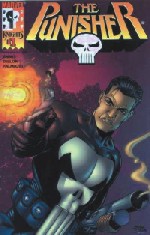 ORIGIN
OF THE PUNISHER
ORIGIN
OF THE PUNISHER
The Punisher was inspired from a character in a novel called War Against
The Mafia, written by Don Pendleton and published in 1968.
The character
of 'The Punisher' first appeared in 'Amazing Spider-Man' number 129,
published in February 1974.
Created and developed
by Gerry Conway and John Romita, The Punisher set out to kill Spider-Man,
acting on the mis-apprehension that Spidey was a criminal. The treacherous
Jackal attempted to persuade The Punisher to kill Spider-Man, and
The Punisher, believing the Jackal was a crimefighter like himself
- and that Spidey was a villain - fought a fierce battle with Peter
Parker's alter-ego before being convinced of his innocence.
The Punisher went
on to make various guest appearances in a host of Marvel titles, including
Daredevil and Captain America, but it wasn't until 1986 that he was
finally given his own comic book series.
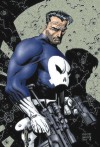 In
1989 a Punisher movie, starring Dolph Lundgren. For this year there
is a new movie to be released April 16th, 2004. Frank Castle (Thomas
Jane) is a man who has seen too much death in his life, first as a
Delta Force Op and later as an FBI special agent. He has managed to
beat considerable odds, and is finally moving out of the field and
into a normal life with his wife and son. On his final assignment,
Castle plays his undercover role perfectly, but the operation spins
out of control. This places the FBI on the wrong side of Tampa businessman
Howard Saint (John Travolta) and his glamorous wife Livia (Laura Harring).
Notwithstanding their glossy social profile, the Saints are no genteel
Florida couple; behind their copious wealth are violent beginnings,
underworld ties and a chilling capacity for brutality. Castle's worst
nightmare is about to come true, as Howard Saint and his lieutenants
unleash hell at the Castle family reunion. But Castle, to his everlasting
torment, survives. Drawing upon all he has learned in 20 years, Castle
sets in motion a brilliant plan to punish the murderers. He takes
up residence among in a dilapidated tenement building on Tampa's industrial
waterfront, where his fellow tenants include Joan (Rebecca Romijn-Stamos),
a waitress at a nearby diner who is trying to put her life back on
track. Castle's neighbors become his last link to the idea of human
community and warmth. It is this makeshift family forgotten men and
women with no one to protect them - who enable Castle to find the
one thing he least expects: redemption.
In
1989 a Punisher movie, starring Dolph Lundgren. For this year there
is a new movie to be released April 16th, 2004. Frank Castle (Thomas
Jane) is a man who has seen too much death in his life, first as a
Delta Force Op and later as an FBI special agent. He has managed to
beat considerable odds, and is finally moving out of the field and
into a normal life with his wife and son. On his final assignment,
Castle plays his undercover role perfectly, but the operation spins
out of control. This places the FBI on the wrong side of Tampa businessman
Howard Saint (John Travolta) and his glamorous wife Livia (Laura Harring).
Notwithstanding their glossy social profile, the Saints are no genteel
Florida couple; behind their copious wealth are violent beginnings,
underworld ties and a chilling capacity for brutality. Castle's worst
nightmare is about to come true, as Howard Saint and his lieutenants
unleash hell at the Castle family reunion. But Castle, to his everlasting
torment, survives. Drawing upon all he has learned in 20 years, Castle
sets in motion a brilliant plan to punish the murderers. He takes
up residence among in a dilapidated tenement building on Tampa's industrial
waterfront, where his fellow tenants include Joan (Rebecca Romijn-Stamos),
a waitress at a nearby diner who is trying to put her life back on
track. Castle's neighbors become his last link to the idea of human
community and warmth. It is this makeshift family forgotten men and
women with no one to protect them - who enable Castle to find the
one thing he least expects: redemption.
Starring: Thomas
Jane, John Travolta, Rebecca Romijn-Stamos, Laura Elena Harring, Samantha
Mathis
Thomas Jane
The next Punisher
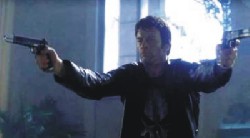 Other
than having a female surname Thomas Jane seems to have everything
else right. He first caught the attention of moviegoers in 1997 as
Beat writer Neal Cassady in the Sundance-screened, Cinemax-aired indie
"The Last Time I Committed Suicide" and a memorable supporting
role as a cocaine addict who concocts a plot to rob a drug dealer
in "Boogie Nights". By that time, though, the actor had
already amassed an intriguing and eclectic resume. Having been raised
in Virginia and his native Maryland, Jane was a 17-year-old high school
senior when he was "discovered" by two Indian producers
searching for a light-haired young man to star in a Romeo and Juliet
inspired love story to be shot in Madras, India. Offered the part,
he dropped out and took the gig. Although he reportedly could have
pursued his career in Bollywood, Jane returned to the USA, reportedly
to reunite with his girlfriend in Maryland.
Other
than having a female surname Thomas Jane seems to have everything
else right. He first caught the attention of moviegoers in 1997 as
Beat writer Neal Cassady in the Sundance-screened, Cinemax-aired indie
"The Last Time I Committed Suicide" and a memorable supporting
role as a cocaine addict who concocts a plot to rob a drug dealer
in "Boogie Nights". By that time, though, the actor had
already amassed an intriguing and eclectic resume. Having been raised
in Virginia and his native Maryland, Jane was a 17-year-old high school
senior when he was "discovered" by two Indian producers
searching for a light-haired young man to star in a Romeo and Juliet
inspired love story to be shot in Madras, India. Offered the part,
he dropped out and took the gig. Although he reportedly could have
pursued his career in Bollywood, Jane returned to the USA, reportedly
to reunite with his girlfriend in Maryland.
He didn't
stay put for long, though. Bitten by the bug, the aspiring thespian
relocated to Los Angeles the following year. Once in Southern California,
he found the going a bit tough, reportedly enduring homelessness in
pursuit of his art. Gradually, Jane landed roles with local theater
companies (going on to co-found The Space Theater). He broke into
American films with a small role in "Buffy the Vampire Slayer"
(billed as Tom Janes). Other bits followed (including the 1993-filmed
"At Ground Zero" in which he was billed as Tom Elliott,
which some sources indicate may be this private performer's real name).
Following a three-year hiatus, he resumed his career with a role in
"The Crow: City of Angels" (1996), now billed as Tom Jane.
 Jane
next landed his first high profile studio lead as a shark wrangler
in "Deep Blue Sea" (1999). Suddenly, his attractive visage
was being featured in magazines and he was being touted as the next
big thing. While he demonstrated he could handle a romantic lead opposite
Elisabeth Shue in "Molly" (also 1999), few bothered to check
out that opus when it played at the multiplexes. In "Magnolia"
(1999), but the actor delivered a nice turn as a hotheaded detective
assisting the cool Morgan Freeman in a murder investigation in "Under
Suspicion" (2000). The small screen actually provided Jane with
one of his best roles, real-life Yankee baseball legend Mickey Mantle
in "61*" (HBO, 2001). Writer-director Billy Crystal told
TV writer Bart Mills of the New York Daily News (April 22-28, 2001):
"Tom couldn't play baseball - not even close. He couldn't catch
or throw, and left-handed he couldn't hit an underhand toss."
Crystal hooked the actor up with Reggie Smith and in less than two
weeks, his abilities were up to par.
Jane
next landed his first high profile studio lead as a shark wrangler
in "Deep Blue Sea" (1999). Suddenly, his attractive visage
was being featured in magazines and he was being touted as the next
big thing. While he demonstrated he could handle a romantic lead opposite
Elisabeth Shue in "Molly" (also 1999), few bothered to check
out that opus when it played at the multiplexes. In "Magnolia"
(1999), but the actor delivered a nice turn as a hotheaded detective
assisting the cool Morgan Freeman in a murder investigation in "Under
Suspicion" (2000). The small screen actually provided Jane with
one of his best roles, real-life Yankee baseball legend Mickey Mantle
in "61*" (HBO, 2001). Writer-director Billy Crystal told
TV writer Bart Mills of the New York Daily News (April 22-28, 2001):
"Tom couldn't play baseball - not even close. He couldn't catch
or throw, and left-handed he couldn't hit an underhand toss."
Crystal hooked the actor up with Reggie Smith and in less than two
weeks, his abilities were up to par.
Continuing
his ascent to stardom, Jane next graced the big screen as part of
a romantic triangle opposite Antonio Banderas and Angelina Jolie in
the period thriller "Original Sin" (2001). He followed up
with starring roles opposite Samantha Morton in "Plain Jane"
(lensed 2001), based on a short story by playwright Arthur Miller,
and Cameron Diaz in the romantic comedy "The Sweetest Thing"
(2002).
